BSBLED805: Comprehensive Plan for Mentoring Program Implementation
VerifiedAdded on 2023/04/08
|10
|1676
|499
Homework Assignment
AI Summary
This assignment solution addresses key aspects of planning and implementing a mentoring program, referencing the BSBLED805 Learner’s Guide and related assessments. It covers the benefits and needs of mentoring programs for both companies and individuals, defining program purposes and objectives, and outlining essential steps for development. The solution details matching criteria, mentoring modes and methods, and the roles and responsibilities of mentors and mentees. It also emphasizes the importance of commitment, identifies reasons for program stagnation or failure, and discusses key components, models, and design principles for effective mentoring programs. Furthermore, it addresses legislative frameworks, resource requirements, data management, and evaluation methods, providing a comprehensive overview of how to create and sustain successful mentoring initiatives. The assignment also includes personal development plans, training plans, and strategies for monitoring mentee relationships, all aimed at achieving organizational objectives and enhancing employee satisfaction. Desklib provides students with access to similar solved assignments and past papers.
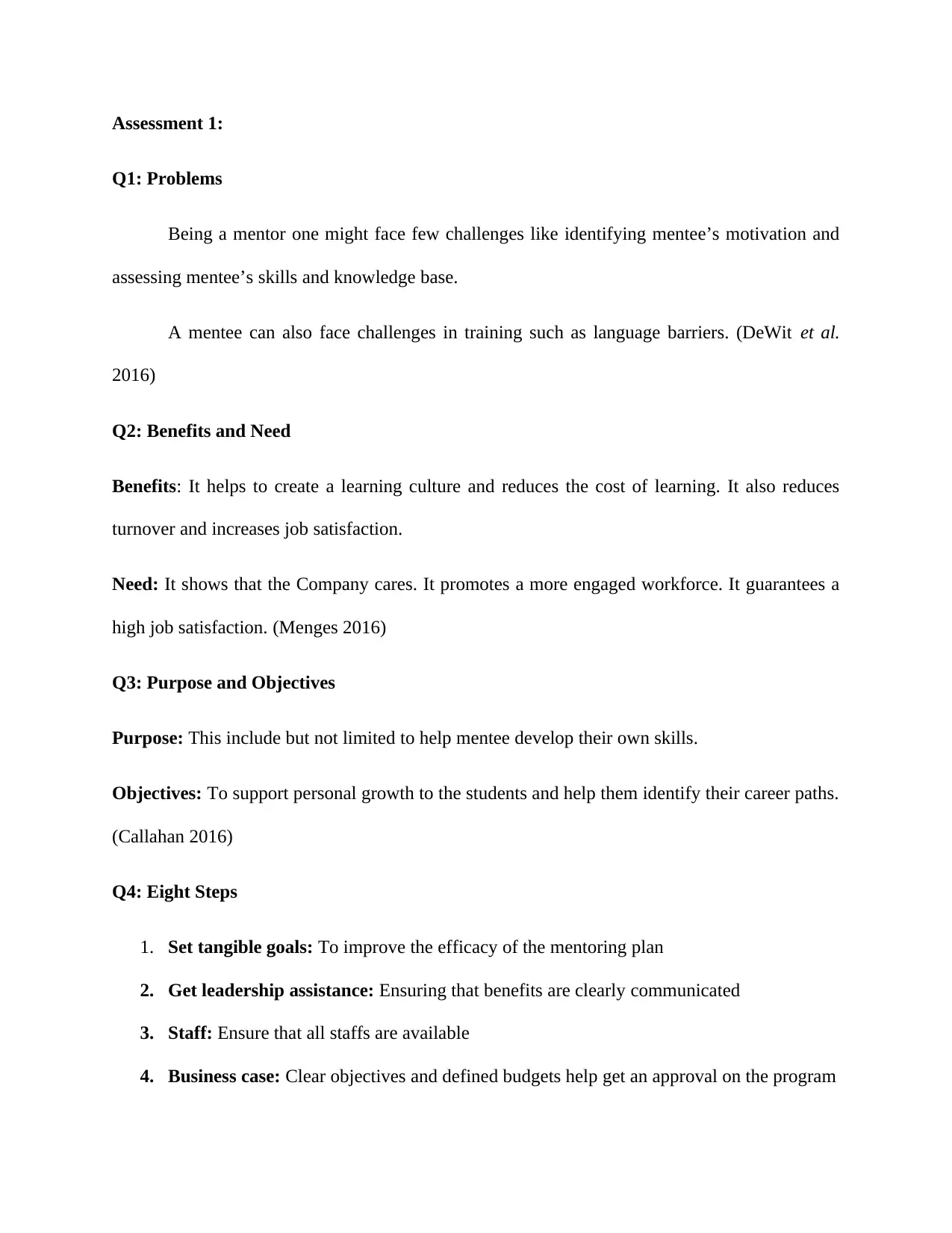
Assessment 1:
Q1: Problems
Being a mentor one might face few challenges like identifying mentee’s motivation and
assessing mentee’s skills and knowledge base.
A mentee can also face challenges in training such as language barriers. (DeWit et al.
2016)
Q2: Benefits and Need
Benefits: It helps to create a learning culture and reduces the cost of learning. It also reduces
turnover and increases job satisfaction.
Need: It shows that the Company cares. It promotes a more engaged workforce. It guarantees a
high job satisfaction. (Menges 2016)
Q3: Purpose and Objectives
Purpose: This include but not limited to help mentee develop their own skills.
Objectives: To support personal growth to the students and help them identify their career paths.
(Callahan 2016)
Q4: Eight Steps
1. Set tangible goals: To improve the efficacy of the mentoring plan
2. Get leadership assistance: Ensuring that benefits are clearly communicated
3. Staff: Ensure that all staffs are available
4. Business case: Clear objectives and defined budgets help get an approval on the program
Q1: Problems
Being a mentor one might face few challenges like identifying mentee’s motivation and
assessing mentee’s skills and knowledge base.
A mentee can also face challenges in training such as language barriers. (DeWit et al.
2016)
Q2: Benefits and Need
Benefits: It helps to create a learning culture and reduces the cost of learning. It also reduces
turnover and increases job satisfaction.
Need: It shows that the Company cares. It promotes a more engaged workforce. It guarantees a
high job satisfaction. (Menges 2016)
Q3: Purpose and Objectives
Purpose: This include but not limited to help mentee develop their own skills.
Objectives: To support personal growth to the students and help them identify their career paths.
(Callahan 2016)
Q4: Eight Steps
1. Set tangible goals: To improve the efficacy of the mentoring plan
2. Get leadership assistance: Ensuring that benefits are clearly communicated
3. Staff: Ensure that all staffs are available
4. Business case: Clear objectives and defined budgets help get an approval on the program
Paraphrase This Document
Need a fresh take? Get an instant paraphrase of this document with our AI Paraphraser
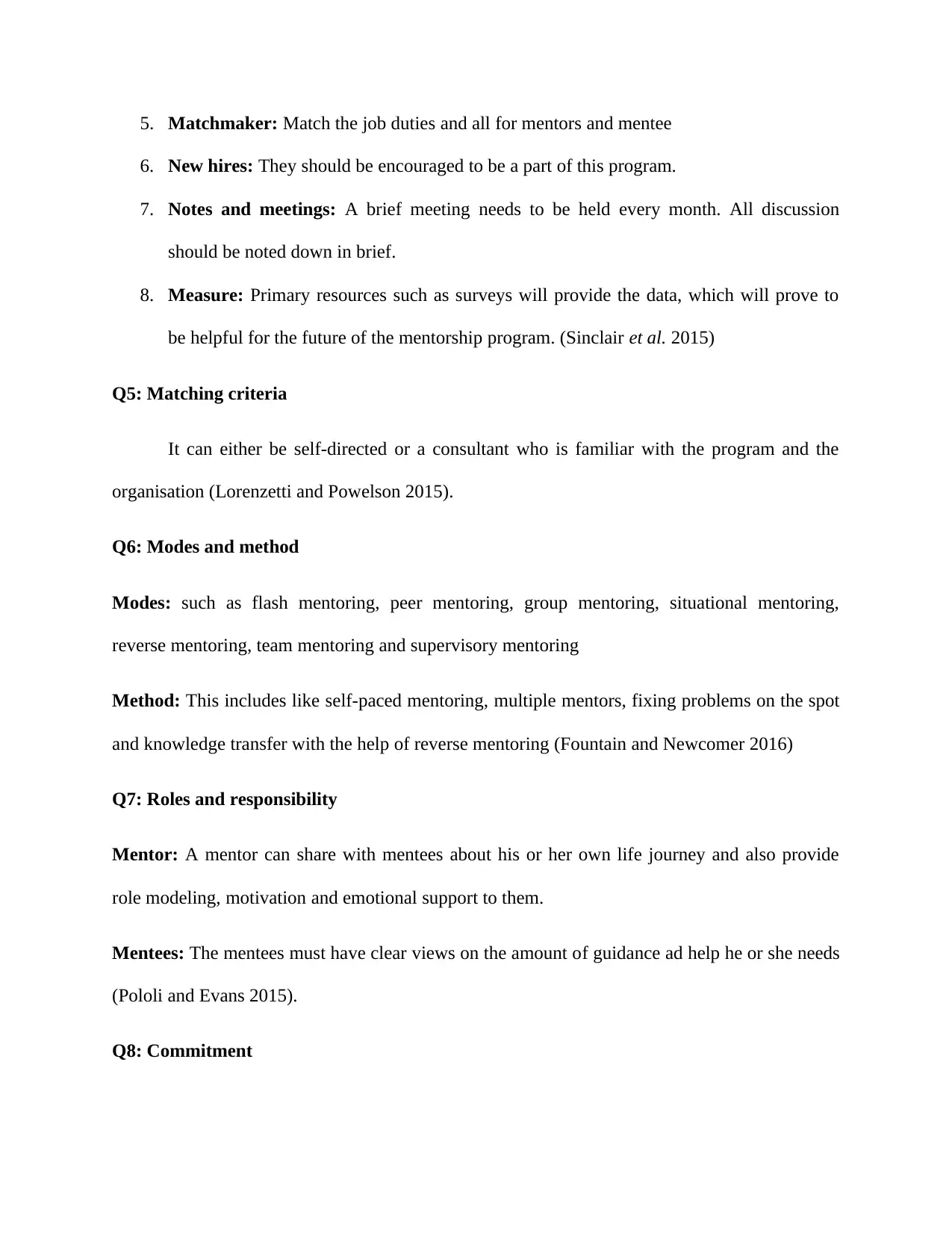
5. Matchmaker: Match the job duties and all for mentors and mentee
6. New hires: They should be encouraged to be a part of this program.
7. Notes and meetings: A brief meeting needs to be held every month. All discussion
should be noted down in brief.
8. Measure: Primary resources such as surveys will provide the data, which will prove to
be helpful for the future of the mentorship program. (Sinclair et al. 2015)
Q5: Matching criteria
It can either be self-directed or a consultant who is familiar with the program and the
organisation (Lorenzetti and Powelson 2015).
Q6: Modes and method
Modes: such as flash mentoring, peer mentoring, group mentoring, situational mentoring,
reverse mentoring, team mentoring and supervisory mentoring
Method: This includes like self-paced mentoring, multiple mentors, fixing problems on the spot
and knowledge transfer with the help of reverse mentoring (Fountain and Newcomer 2016)
Q7: Roles and responsibility
Mentor: A mentor can share with mentees about his or her own life journey and also provide
role modeling, motivation and emotional support to them.
Mentees: The mentees must have clear views on the amount of guidance ad help he or she needs
(Pololi and Evans 2015).
Q8: Commitment
6. New hires: They should be encouraged to be a part of this program.
7. Notes and meetings: A brief meeting needs to be held every month. All discussion
should be noted down in brief.
8. Measure: Primary resources such as surveys will provide the data, which will prove to
be helpful for the future of the mentorship program. (Sinclair et al. 2015)
Q5: Matching criteria
It can either be self-directed or a consultant who is familiar with the program and the
organisation (Lorenzetti and Powelson 2015).
Q6: Modes and method
Modes: such as flash mentoring, peer mentoring, group mentoring, situational mentoring,
reverse mentoring, team mentoring and supervisory mentoring
Method: This includes like self-paced mentoring, multiple mentors, fixing problems on the spot
and knowledge transfer with the help of reverse mentoring (Fountain and Newcomer 2016)
Q7: Roles and responsibility
Mentor: A mentor can share with mentees about his or her own life journey and also provide
role modeling, motivation and emotional support to them.
Mentees: The mentees must have clear views on the amount of guidance ad help he or she needs
(Pololi and Evans 2015).
Q8: Commitment
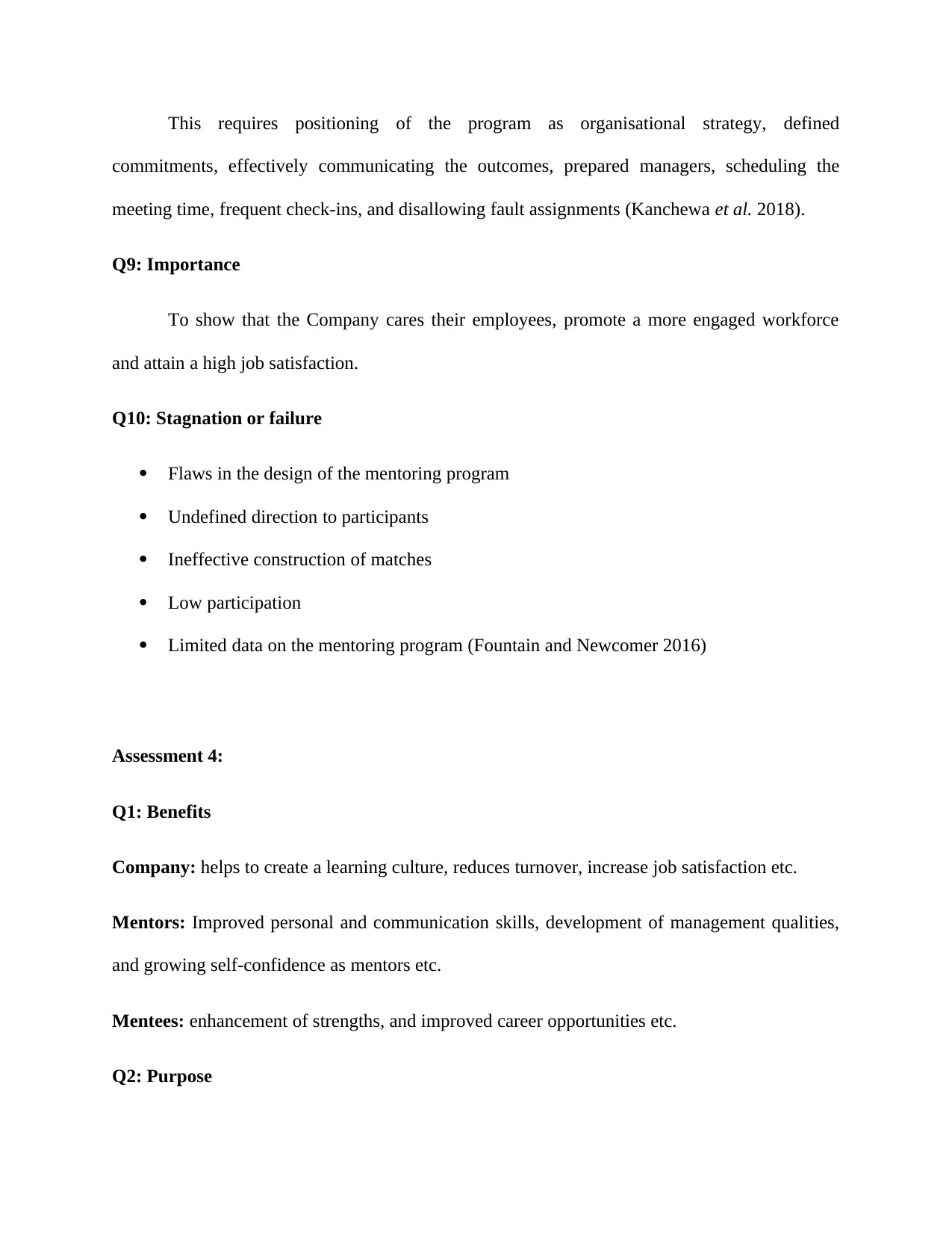
This requires positioning of the program as organisational strategy, defined
commitments, effectively communicating the outcomes, prepared managers, scheduling the
meeting time, frequent check-ins, and disallowing fault assignments (Kanchewa et al. 2018).
Q9: Importance
To show that the Company cares their employees, promote a more engaged workforce
and attain a high job satisfaction.
Q10: Stagnation or failure
Flaws in the design of the mentoring program
Undefined direction to participants
Ineffective construction of matches
Low participation
Limited data on the mentoring program (Fountain and Newcomer 2016)
Assessment 4:
Q1: Benefits
Company: helps to create a learning culture, reduces turnover, increase job satisfaction etc.
Mentors: Improved personal and communication skills, development of management qualities,
and growing self-confidence as mentors etc.
Mentees: enhancement of strengths, and improved career opportunities etc.
Q2: Purpose
commitments, effectively communicating the outcomes, prepared managers, scheduling the
meeting time, frequent check-ins, and disallowing fault assignments (Kanchewa et al. 2018).
Q9: Importance
To show that the Company cares their employees, promote a more engaged workforce
and attain a high job satisfaction.
Q10: Stagnation or failure
Flaws in the design of the mentoring program
Undefined direction to participants
Ineffective construction of matches
Low participation
Limited data on the mentoring program (Fountain and Newcomer 2016)
Assessment 4:
Q1: Benefits
Company: helps to create a learning culture, reduces turnover, increase job satisfaction etc.
Mentors: Improved personal and communication skills, development of management qualities,
and growing self-confidence as mentors etc.
Mentees: enhancement of strengths, and improved career opportunities etc.
Q2: Purpose
⊘ This is a preview!⊘
Do you want full access?
Subscribe today to unlock all pages.

Trusted by 1+ million students worldwide
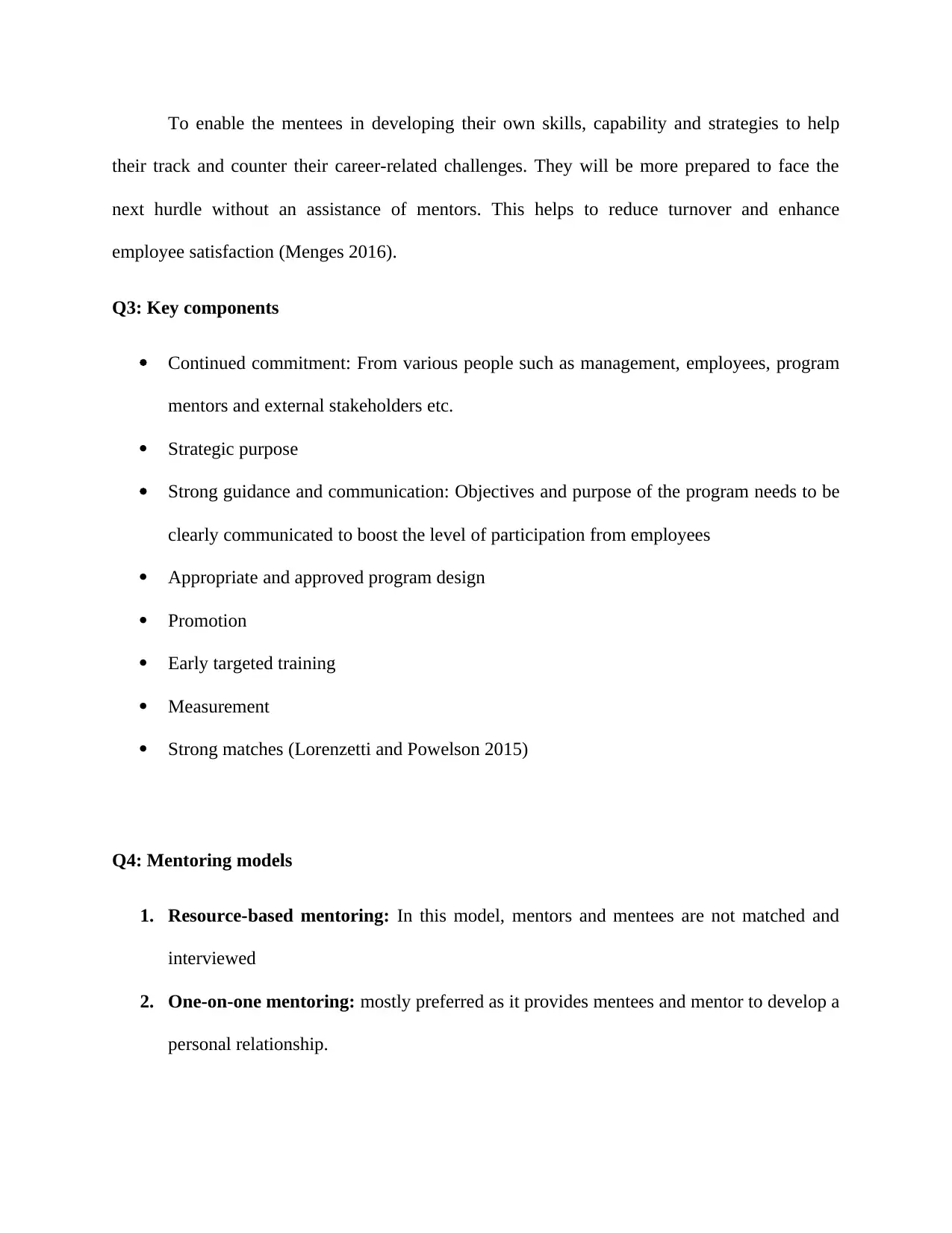
To enable the mentees in developing their own skills, capability and strategies to help
their track and counter their career-related challenges. They will be more prepared to face the
next hurdle without an assistance of mentors. This helps to reduce turnover and enhance
employee satisfaction (Menges 2016).
Q3: Key components
Continued commitment: From various people such as management, employees, program
mentors and external stakeholders etc.
Strategic purpose
Strong guidance and communication: Objectives and purpose of the program needs to be
clearly communicated to boost the level of participation from employees
Appropriate and approved program design
Promotion
Early targeted training
Measurement
Strong matches (Lorenzetti and Powelson 2015)
Q4: Mentoring models
1. Resource-based mentoring: In this model, mentors and mentees are not matched and
interviewed
2. One-on-one mentoring: mostly preferred as it provides mentees and mentor to develop a
personal relationship.
their track and counter their career-related challenges. They will be more prepared to face the
next hurdle without an assistance of mentors. This helps to reduce turnover and enhance
employee satisfaction (Menges 2016).
Q3: Key components
Continued commitment: From various people such as management, employees, program
mentors and external stakeholders etc.
Strategic purpose
Strong guidance and communication: Objectives and purpose of the program needs to be
clearly communicated to boost the level of participation from employees
Appropriate and approved program design
Promotion
Early targeted training
Measurement
Strong matches (Lorenzetti and Powelson 2015)
Q4: Mentoring models
1. Resource-based mentoring: In this model, mentors and mentees are not matched and
interviewed
2. One-on-one mentoring: mostly preferred as it provides mentees and mentor to develop a
personal relationship.
Paraphrase This Document
Need a fresh take? Get an instant paraphrase of this document with our AI Paraphraser
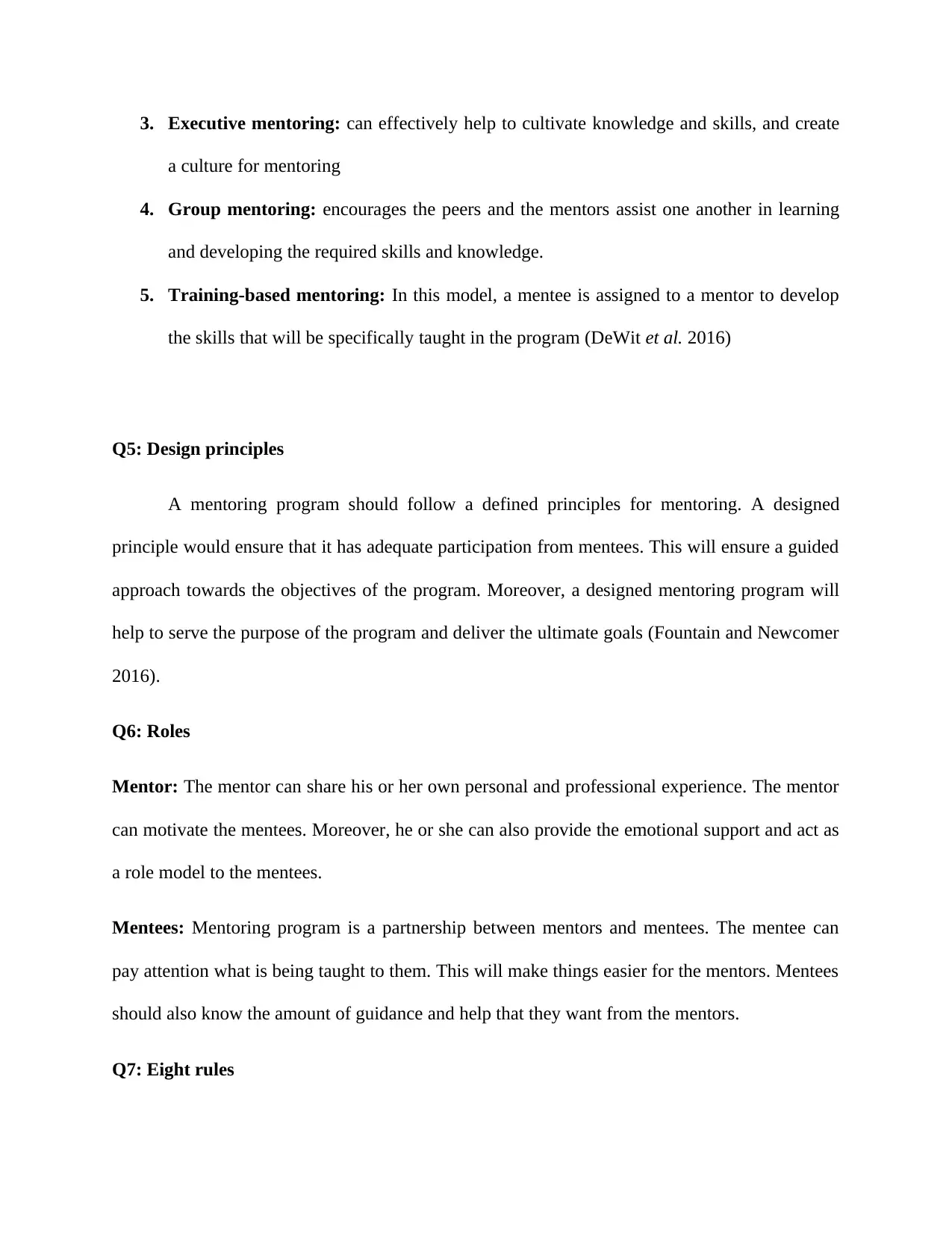
3. Executive mentoring: can effectively help to cultivate knowledge and skills, and create
a culture for mentoring
4. Group mentoring: encourages the peers and the mentors assist one another in learning
and developing the required skills and knowledge.
5. Training-based mentoring: In this model, a mentee is assigned to a mentor to develop
the skills that will be specifically taught in the program (DeWit et al. 2016)
Q5: Design principles
A mentoring program should follow a defined principles for mentoring. A designed
principle would ensure that it has adequate participation from mentees. This will ensure a guided
approach towards the objectives of the program. Moreover, a designed mentoring program will
help to serve the purpose of the program and deliver the ultimate goals (Fountain and Newcomer
2016).
Q6: Roles
Mentor: The mentor can share his or her own personal and professional experience. The mentor
can motivate the mentees. Moreover, he or she can also provide the emotional support and act as
a role model to the mentees.
Mentees: Mentoring program is a partnership between mentors and mentees. The mentee can
pay attention what is being taught to them. This will make things easier for the mentors. Mentees
should also know the amount of guidance and help that they want from the mentors.
Q7: Eight rules
a culture for mentoring
4. Group mentoring: encourages the peers and the mentors assist one another in learning
and developing the required skills and knowledge.
5. Training-based mentoring: In this model, a mentee is assigned to a mentor to develop
the skills that will be specifically taught in the program (DeWit et al. 2016)
Q5: Design principles
A mentoring program should follow a defined principles for mentoring. A designed
principle would ensure that it has adequate participation from mentees. This will ensure a guided
approach towards the objectives of the program. Moreover, a designed mentoring program will
help to serve the purpose of the program and deliver the ultimate goals (Fountain and Newcomer
2016).
Q6: Roles
Mentor: The mentor can share his or her own personal and professional experience. The mentor
can motivate the mentees. Moreover, he or she can also provide the emotional support and act as
a role model to the mentees.
Mentees: Mentoring program is a partnership between mentors and mentees. The mentee can
pay attention what is being taught to them. This will make things easier for the mentors. Mentees
should also know the amount of guidance and help that they want from the mentors.
Q7: Eight rules
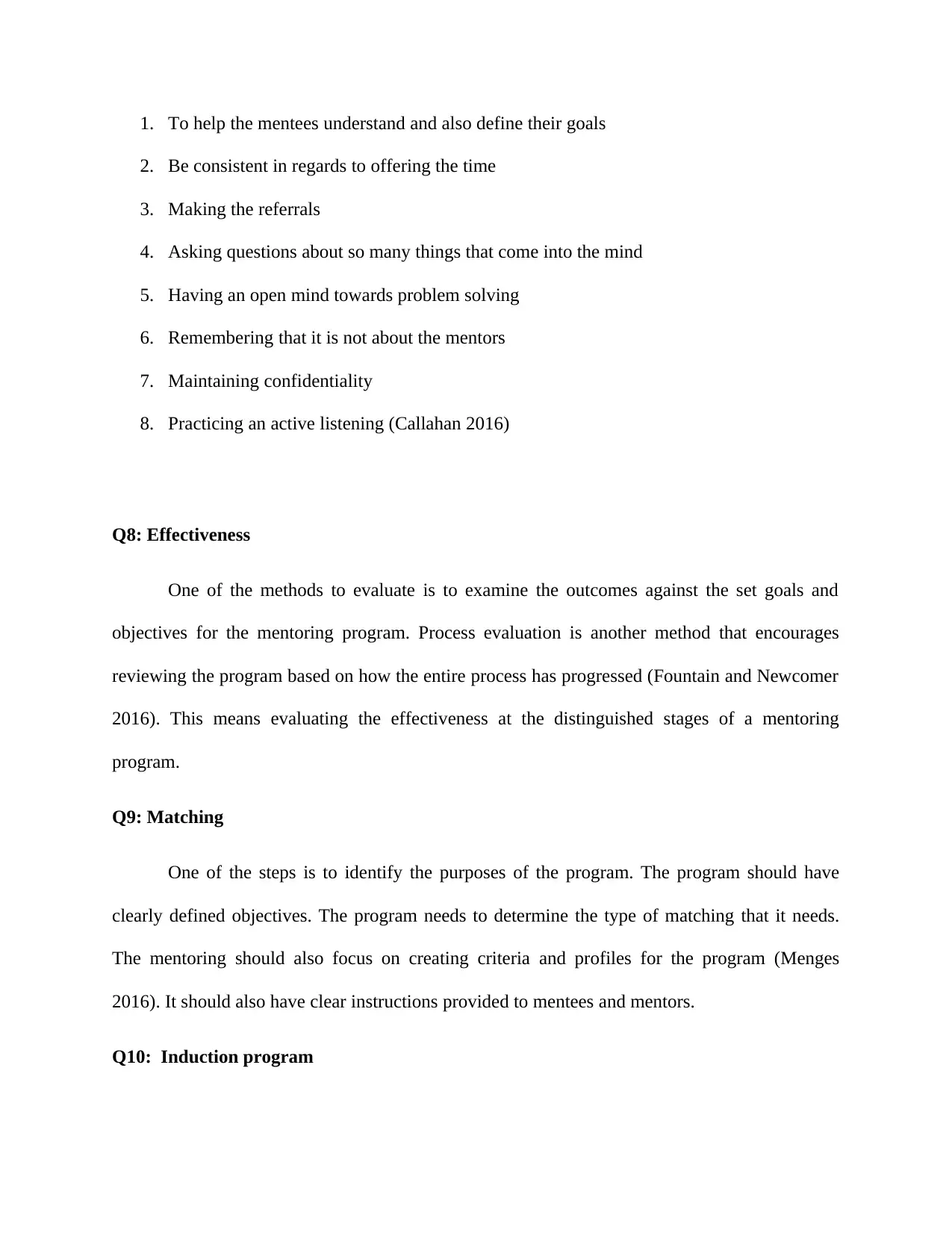
1. To help the mentees understand and also define their goals
2. Be consistent in regards to offering the time
3. Making the referrals
4. Asking questions about so many things that come into the mind
5. Having an open mind towards problem solving
6. Remembering that it is not about the mentors
7. Maintaining confidentiality
8. Practicing an active listening (Callahan 2016)
Q8: Effectiveness
One of the methods to evaluate is to examine the outcomes against the set goals and
objectives for the mentoring program. Process evaluation is another method that encourages
reviewing the program based on how the entire process has progressed (Fountain and Newcomer
2016). This means evaluating the effectiveness at the distinguished stages of a mentoring
program.
Q9: Matching
One of the steps is to identify the purposes of the program. The program should have
clearly defined objectives. The program needs to determine the type of matching that it needs.
The mentoring should also focus on creating criteria and profiles for the program (Menges
2016). It should also have clear instructions provided to mentees and mentors.
Q10: Induction program
2. Be consistent in regards to offering the time
3. Making the referrals
4. Asking questions about so many things that come into the mind
5. Having an open mind towards problem solving
6. Remembering that it is not about the mentors
7. Maintaining confidentiality
8. Practicing an active listening (Callahan 2016)
Q8: Effectiveness
One of the methods to evaluate is to examine the outcomes against the set goals and
objectives for the mentoring program. Process evaluation is another method that encourages
reviewing the program based on how the entire process has progressed (Fountain and Newcomer
2016). This means evaluating the effectiveness at the distinguished stages of a mentoring
program.
Q9: Matching
One of the steps is to identify the purposes of the program. The program should have
clearly defined objectives. The program needs to determine the type of matching that it needs.
The mentoring should also focus on creating criteria and profiles for the program (Menges
2016). It should also have clear instructions provided to mentees and mentors.
Q10: Induction program
⊘ This is a preview!⊘
Do you want full access?
Subscribe today to unlock all pages.

Trusted by 1+ million students worldwide
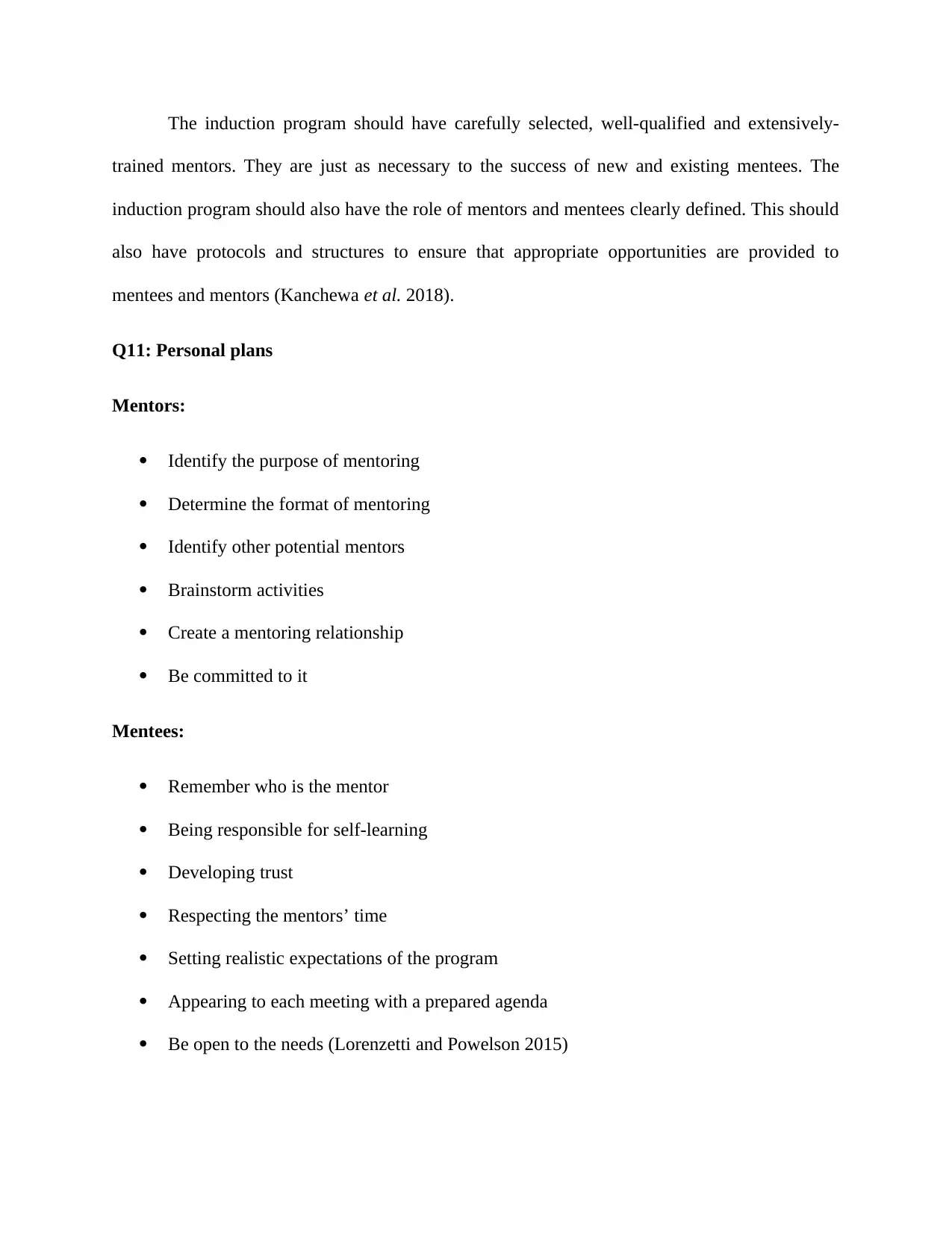
The induction program should have carefully selected, well-qualified and extensively-
trained mentors. They are just as necessary to the success of new and existing mentees. The
induction program should also have the role of mentors and mentees clearly defined. This should
also have protocols and structures to ensure that appropriate opportunities are provided to
mentees and mentors (Kanchewa et al. 2018).
Q11: Personal plans
Mentors:
Identify the purpose of mentoring
Determine the format of mentoring
Identify other potential mentors
Brainstorm activities
Create a mentoring relationship
Be committed to it
Mentees:
Remember who is the mentor
Being responsible for self-learning
Developing trust
Respecting the mentors’ time
Setting realistic expectations of the program
Appearing to each meeting with a prepared agenda
Be open to the needs (Lorenzetti and Powelson 2015)
trained mentors. They are just as necessary to the success of new and existing mentees. The
induction program should also have the role of mentors and mentees clearly defined. This should
also have protocols and structures to ensure that appropriate opportunities are provided to
mentees and mentors (Kanchewa et al. 2018).
Q11: Personal plans
Mentors:
Identify the purpose of mentoring
Determine the format of mentoring
Identify other potential mentors
Brainstorm activities
Create a mentoring relationship
Be committed to it
Mentees:
Remember who is the mentor
Being responsible for self-learning
Developing trust
Respecting the mentors’ time
Setting realistic expectations of the program
Appearing to each meeting with a prepared agenda
Be open to the needs (Lorenzetti and Powelson 2015)
Paraphrase This Document
Need a fresh take? Get an instant paraphrase of this document with our AI Paraphraser
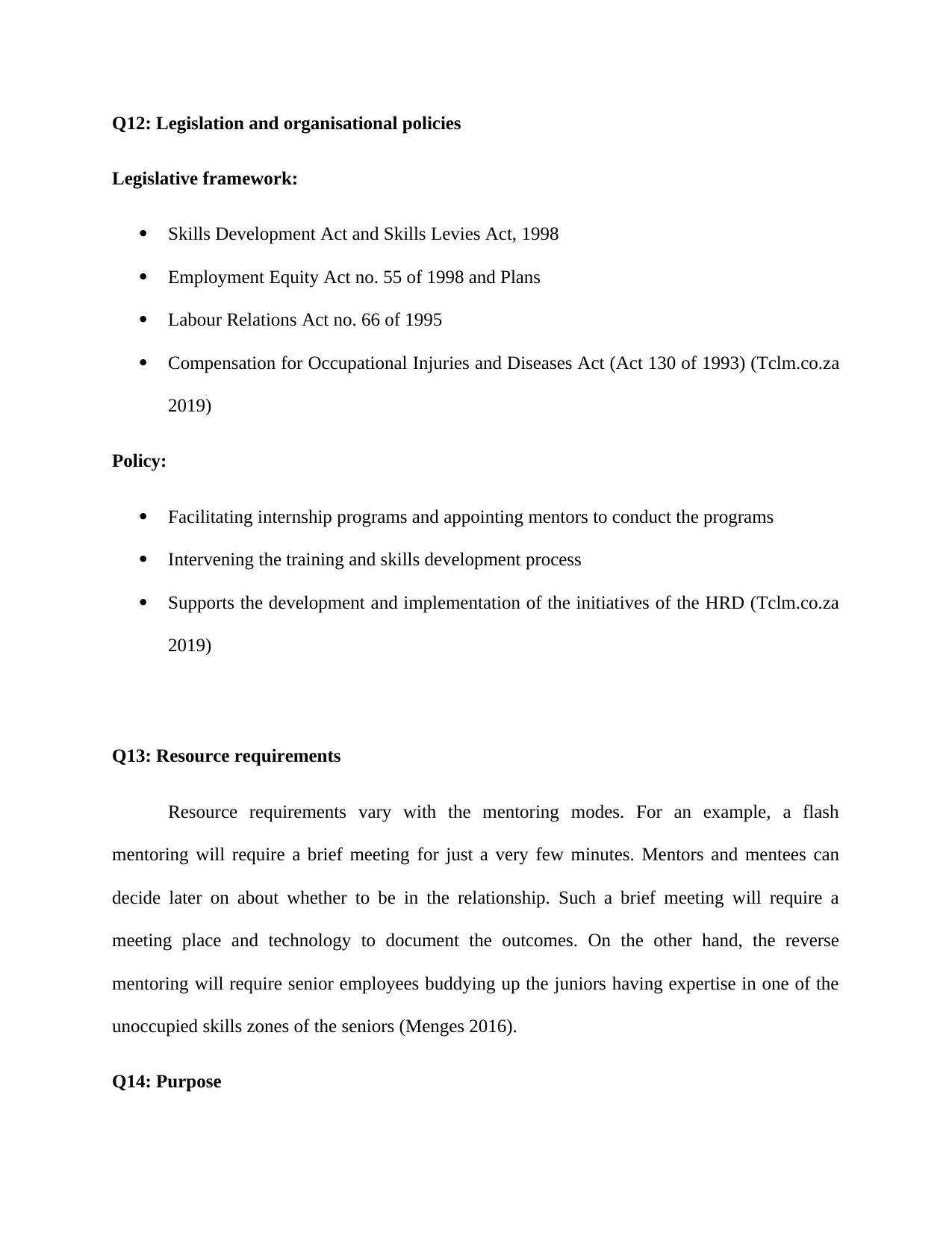
Q12: Legislation and organisational policies
Legislative framework:
Skills Development Act and Skills Levies Act, 1998
Employment Equity Act no. 55 of 1998 and Plans
Labour Relations Act no. 66 of 1995
Compensation for Occupational Injuries and Diseases Act (Act 130 of 1993) (Tclm.co.za
2019)
Policy:
Facilitating internship programs and appointing mentors to conduct the programs
Intervening the training and skills development process
Supports the development and implementation of the initiatives of the HRD (Tclm.co.za
2019)
Q13: Resource requirements
Resource requirements vary with the mentoring modes. For an example, a flash
mentoring will require a brief meeting for just a very few minutes. Mentors and mentees can
decide later on about whether to be in the relationship. Such a brief meeting will require a
meeting place and technology to document the outcomes. On the other hand, the reverse
mentoring will require senior employees buddying up the juniors having expertise in one of the
unoccupied skills zones of the seniors (Menges 2016).
Q14: Purpose
Legislative framework:
Skills Development Act and Skills Levies Act, 1998
Employment Equity Act no. 55 of 1998 and Plans
Labour Relations Act no. 66 of 1995
Compensation for Occupational Injuries and Diseases Act (Act 130 of 1993) (Tclm.co.za
2019)
Policy:
Facilitating internship programs and appointing mentors to conduct the programs
Intervening the training and skills development process
Supports the development and implementation of the initiatives of the HRD (Tclm.co.za
2019)
Q13: Resource requirements
Resource requirements vary with the mentoring modes. For an example, a flash
mentoring will require a brief meeting for just a very few minutes. Mentors and mentees can
decide later on about whether to be in the relationship. Such a brief meeting will require a
meeting place and technology to document the outcomes. On the other hand, the reverse
mentoring will require senior employees buddying up the juniors having expertise in one of the
unoccupied skills zones of the seniors (Menges 2016).
Q14: Purpose
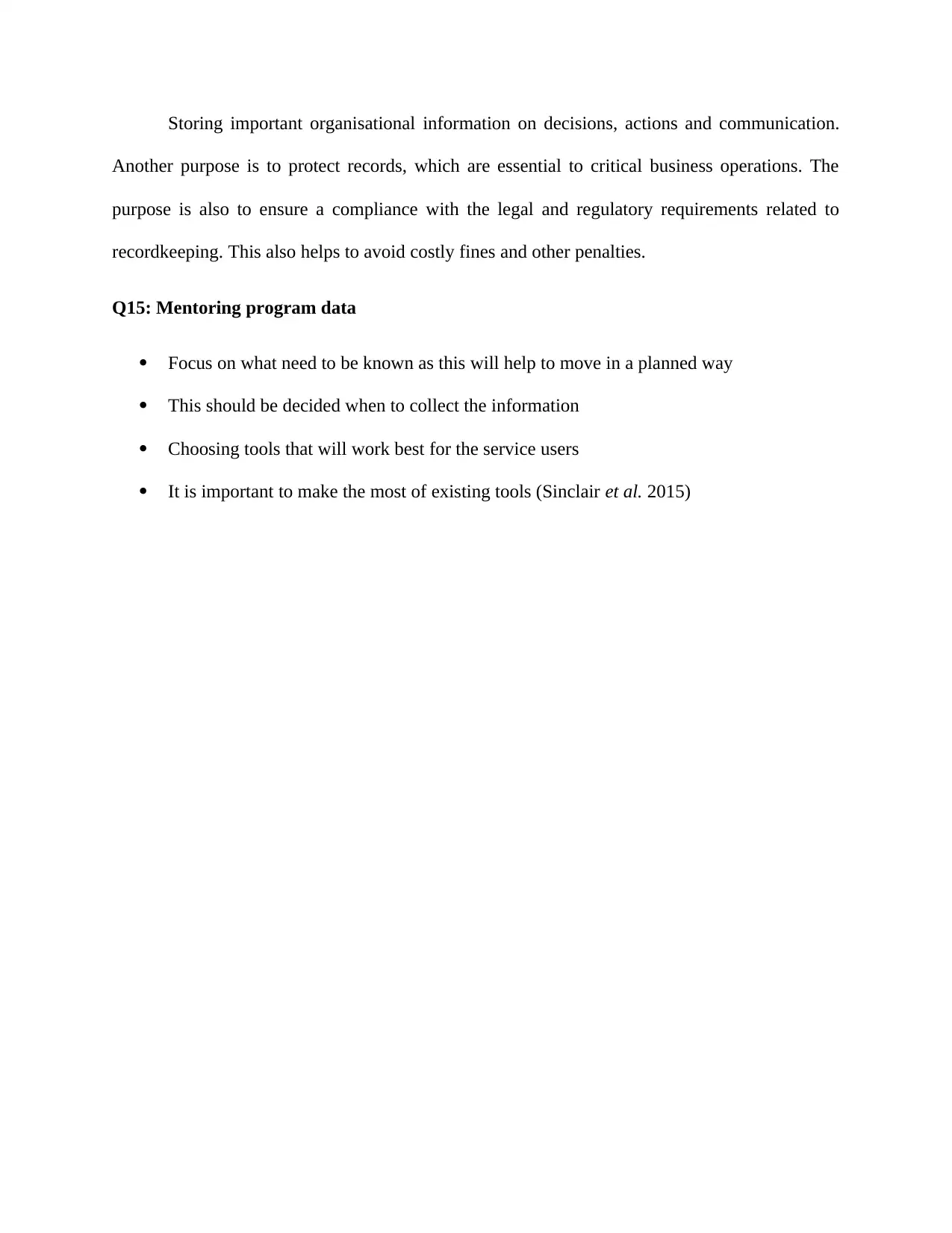
Storing important organisational information on decisions, actions and communication.
Another purpose is to protect records, which are essential to critical business operations. The
purpose is also to ensure a compliance with the legal and regulatory requirements related to
recordkeeping. This also helps to avoid costly fines and other penalties.
Q15: Mentoring program data
Focus on what need to be known as this will help to move in a planned way
This should be decided when to collect the information
Choosing tools that will work best for the service users
It is important to make the most of existing tools (Sinclair et al. 2015)
Another purpose is to protect records, which are essential to critical business operations. The
purpose is also to ensure a compliance with the legal and regulatory requirements related to
recordkeeping. This also helps to avoid costly fines and other penalties.
Q15: Mentoring program data
Focus on what need to be known as this will help to move in a planned way
This should be decided when to collect the information
Choosing tools that will work best for the service users
It is important to make the most of existing tools (Sinclair et al. 2015)
⊘ This is a preview!⊘
Do you want full access?
Subscribe today to unlock all pages.

Trusted by 1+ million students worldwide
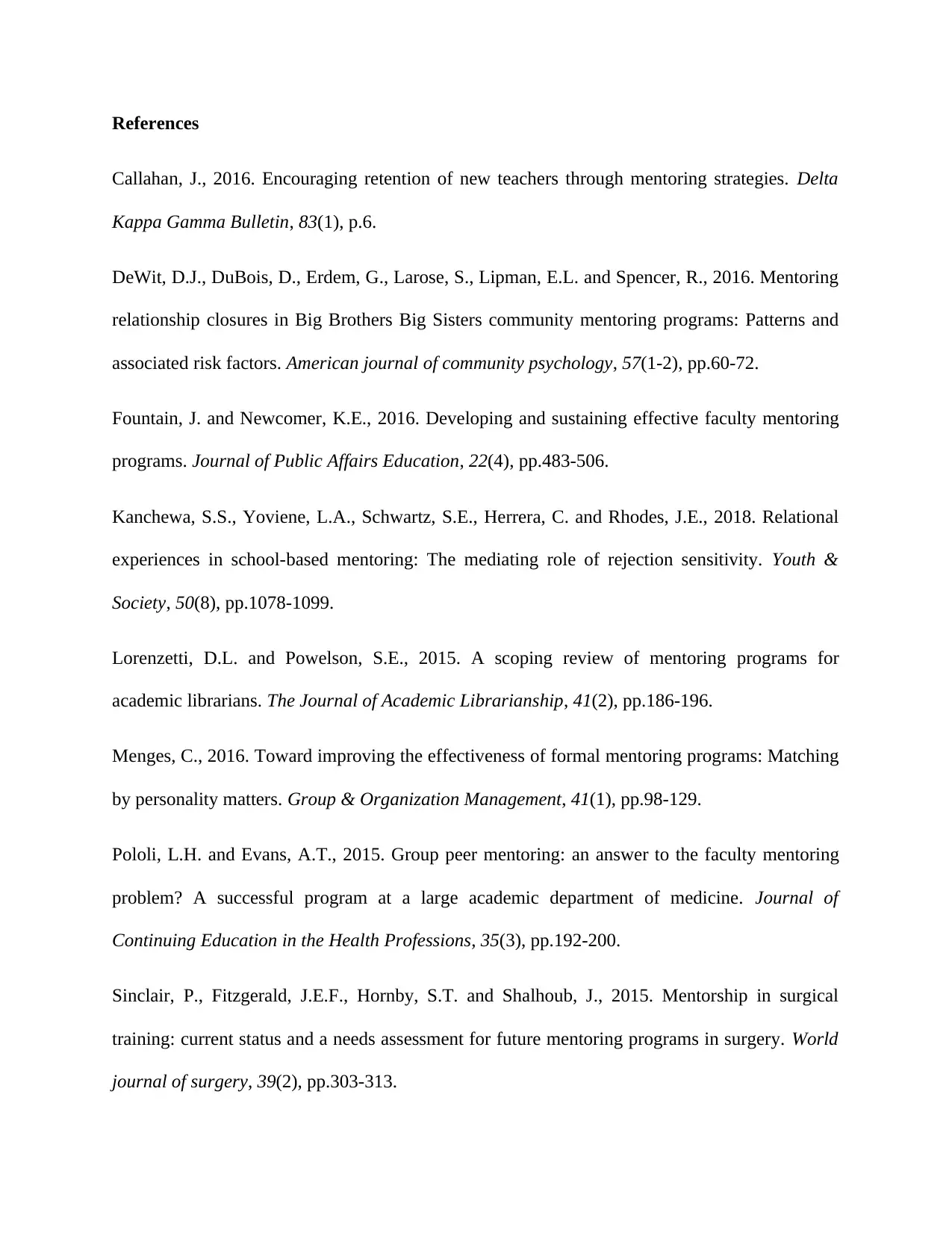
References
Callahan, J., 2016. Encouraging retention of new teachers through mentoring strategies. Delta
Kappa Gamma Bulletin, 83(1), p.6.
DeWit, D.J., DuBois, D., Erdem, G., Larose, S., Lipman, E.L. and Spencer, R., 2016. Mentoring
relationship closures in Big Brothers Big Sisters community mentoring programs: Patterns and
associated risk factors. American journal of community psychology, 57(1-2), pp.60-72.
Fountain, J. and Newcomer, K.E., 2016. Developing and sustaining effective faculty mentoring
programs. Journal of Public Affairs Education, 22(4), pp.483-506.
Kanchewa, S.S., Yoviene, L.A., Schwartz, S.E., Herrera, C. and Rhodes, J.E., 2018. Relational
experiences in school-based mentoring: The mediating role of rejection sensitivity. Youth &
Society, 50(8), pp.1078-1099.
Lorenzetti, D.L. and Powelson, S.E., 2015. A scoping review of mentoring programs for
academic librarians. The Journal of Academic Librarianship, 41(2), pp.186-196.
Menges, C., 2016. Toward improving the effectiveness of formal mentoring programs: Matching
by personality matters. Group & Organization Management, 41(1), pp.98-129.
Pololi, L.H. and Evans, A.T., 2015. Group peer mentoring: an answer to the faculty mentoring
problem? A successful program at a large academic department of medicine. Journal of
Continuing Education in the Health Professions, 35(3), pp.192-200.
Sinclair, P., Fitzgerald, J.E.F., Hornby, S.T. and Shalhoub, J., 2015. Mentorship in surgical
training: current status and a needs assessment for future mentoring programs in surgery. World
journal of surgery, 39(2), pp.303-313.
Callahan, J., 2016. Encouraging retention of new teachers through mentoring strategies. Delta
Kappa Gamma Bulletin, 83(1), p.6.
DeWit, D.J., DuBois, D., Erdem, G., Larose, S., Lipman, E.L. and Spencer, R., 2016. Mentoring
relationship closures in Big Brothers Big Sisters community mentoring programs: Patterns and
associated risk factors. American journal of community psychology, 57(1-2), pp.60-72.
Fountain, J. and Newcomer, K.E., 2016. Developing and sustaining effective faculty mentoring
programs. Journal of Public Affairs Education, 22(4), pp.483-506.
Kanchewa, S.S., Yoviene, L.A., Schwartz, S.E., Herrera, C. and Rhodes, J.E., 2018. Relational
experiences in school-based mentoring: The mediating role of rejection sensitivity. Youth &
Society, 50(8), pp.1078-1099.
Lorenzetti, D.L. and Powelson, S.E., 2015. A scoping review of mentoring programs for
academic librarians. The Journal of Academic Librarianship, 41(2), pp.186-196.
Menges, C., 2016. Toward improving the effectiveness of formal mentoring programs: Matching
by personality matters. Group & Organization Management, 41(1), pp.98-129.
Pololi, L.H. and Evans, A.T., 2015. Group peer mentoring: an answer to the faculty mentoring
problem? A successful program at a large academic department of medicine. Journal of
Continuing Education in the Health Professions, 35(3), pp.192-200.
Sinclair, P., Fitzgerald, J.E.F., Hornby, S.T. and Shalhoub, J., 2015. Mentorship in surgical
training: current status and a needs assessment for future mentoring programs in surgery. World
journal of surgery, 39(2), pp.303-313.
1 out of 10
Related Documents
Your All-in-One AI-Powered Toolkit for Academic Success.
+13062052269
info@desklib.com
Available 24*7 on WhatsApp / Email
![[object Object]](/_next/static/media/star-bottom.7253800d.svg)
Unlock your academic potential
Copyright © 2020–2025 A2Z Services. All Rights Reserved. Developed and managed by ZUCOL.





